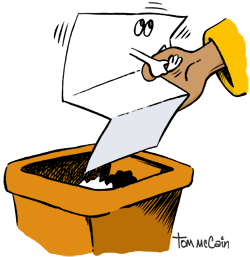 One of the biggest mistakes designers can make is ignoring the envelope that contains their client’s direct mail components. Envelopes are the key tool that determines whether your direct mail gets opened or gets ditched.
One of the biggest mistakes designers can make is ignoring the envelope that contains their client’s direct mail components. Envelopes are the key tool that determines whether your direct mail gets opened or gets ditched.
Design Tips for Creating Intriguing Envelopes for Your Direct Mail Campaign.
- Vary the size: think outside of the standard #10 envelope. Look at oversized envelopes or even undersized. Anything to break out of the normal in-box clutter.
- Use color: consider envelopes that reflect your brand’s primary color or consider anything that isn’t white, yet fits your offer. White envelopes tend to blend in with everything else in the recipient’s mailbox. Consult your designer or printer for interesting textures and colors.
- Print a teaser message on the envelope: the operative word here is ‘teaser.’ There’s no rule that says you need to give it all away up front. Leave a little something to reward them for opening. Keep the message enticing.
- Consider using a translucent or clear envelope: if your budget allows, there are a myriad of clear and translucent options. Choices include vellum, glassine and polybag-type envelopes. But be cautious when sourcing vellum as not all are crack resistant. Consult with your printer for vellum options that minimize cracking. And also don’t assume that polybag-type envelopes are only available in crystal clear. There are many exciting color choices that ignite the imagination. ClearBags has a great online resource to get your creative juices flowing, but do work you’re your printer for larger quantities.
- Consider the design of the interior components up front. Don’t’ just toss them in a clear envelope without thought to what will show through. Again, you may need to redesign the outward facing messages on the interior components if you’re using a clear envelope.
- You may also consider window envelopes as an alternative to solid paper or clear poly envelopes. There are several sizes including booklet envelopes with nearly full-view windows that deliver a similar effect.
Production Considerations.
- If going with a translucent or clear envelope, you’ll have to reconsider how you handle addressing the envelope. Depending on the color and translucency of the material, you may have to use an address label. Or you could design the backside of the inserts to contain the address info.
- Remember what I said about vellum. While insanely cool, you must work with a good printer to spec a stock that is crack resistant.
- Some envelopes don’t come with a sticky seal. Some glassine envelopes, for instance, may require you to use a label to close the flap. This is another opportunity for messaging.
- While an envelope mailer will cost more to produce than a postcard, a well-designed envelope can outperform a postcard if the message is right for a closed-envelope package. The challenges are the budget, of course, and ensuring the envelope is the right vehicle for your direct mail’s desired outcome.
- Spec converted envelopes to save money. The only drawback is that you won’t be able to print across folds or bleed off a cut edge. But a good designer can certainly work within these restrictions to save you money.
Ignore at your own peril the envelope’s ability to tease, entice, intrigue and seduce the recipient. But also remember what mom advised in your youth: don’t give it all away up front and do leave something to the imagination. Envelopes are no different. Enticing someone to open is often a matter of making a promise but only enough to generate excitement. Like wearing just the right dress on your first date. Not too much, not too little.
By Julia Moran Martz








